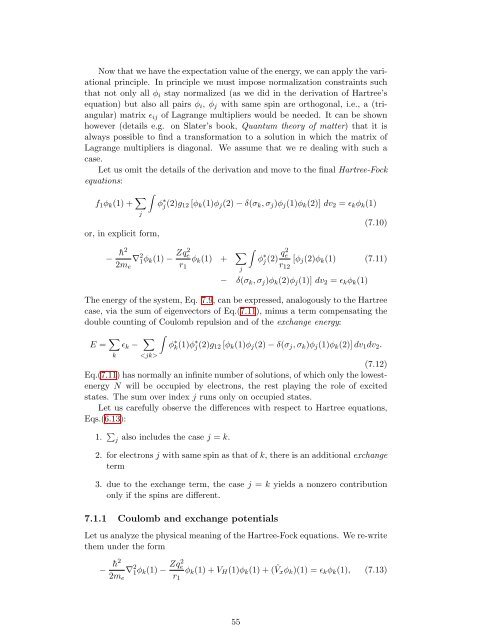Numerical Methods in Quantum Mechanics - Dipartimento di Fisica
Numerical Methods in Quantum Mechanics - Dipartimento di Fisica
Numerical Methods in Quantum Mechanics - Dipartimento di Fisica
Create successful ePaper yourself
Turn your PDF publications into a flip-book with our unique Google optimized e-Paper software.
Now that we have the expectation value of the energy, we can apply the variational<br />
pr<strong>in</strong>ciple. In pr<strong>in</strong>ciple we must impose normalization constra<strong>in</strong>ts such<br />
that not only all φ i stay normalized (as we <strong>di</strong>d <strong>in</strong> the derivation of Hartree’s<br />
equation) but also all pairs φ i , φ j with same sp<strong>in</strong> are orthogonal, i.e., a (triangular)<br />
matrix ɛ ij of Lagrange multipliers would be needed. It can be shown<br />
however (details e.g. on Slater’s book, <strong>Quantum</strong> theory of matter) that it is<br />
always possible to f<strong>in</strong>d a transformation to a solution <strong>in</strong> which the matrix of<br />
Lagrange multipliers is <strong>di</strong>agonal. We assume that we re deal<strong>in</strong>g with such a<br />
case.<br />
Let us omit the details of the derivation and move to the f<strong>in</strong>al Hartree-Fock<br />
equations:<br />
f 1 φ k (1) + ∑ ∫<br />
φ ∗ j(2)g 12 [φ k (1)φ j (2) − δ(σ k , σ j )φ j (1)φ k (2)] dv 2 = ɛ k φ k (1)<br />
j<br />
(7.10)<br />
or, <strong>in</strong> explicit form,<br />
− ¯h2<br />
2m e<br />
∇ 2 1φ k (1) − Zq2 e<br />
r 1<br />
φ k (1) + ∑ j<br />
∫<br />
φ ∗ j(2) q2 e<br />
r 12<br />
[φ j (2)φ k (1) (7.11)<br />
− δ(σ k , σ j )φ k (2)φ j (1)] dv 2 = ɛ k φ k (1)<br />
The energy of the system, Eq. 7.9, can be expressed, analogously to the Hartree<br />
case, via the sum of eigenvectors of Eq.(7.11), m<strong>in</strong>us a term compensat<strong>in</strong>g the<br />
double count<strong>in</strong>g of Coulomb repulsion and of the exchange energy:<br />
E = ∑ ɛ k − ∑ ∫<br />
φ ∗ k(1)φ ∗ j(2)g 12 [φ k (1)φ j (2) − δ(σ j , σ k )φ j (1)φ k (2)] dv 1 dv 2 .<br />
k <br />
(7.12)<br />
Eq.(7.11) has normally an <strong>in</strong>f<strong>in</strong>ite number of solutions, of which only the lowestenergy<br />
N will be occupied by electrons, the rest play<strong>in</strong>g the role of excited<br />
states. The sum over <strong>in</strong>dex j runs only on occupied states.<br />
Let us carefully observe the <strong>di</strong>fferences with respect to Hartree equations,<br />
Eqs.(6.13):<br />
1. ∑ j<br />
also <strong>in</strong>cludes the case j = k.<br />
2. for electrons j with same sp<strong>in</strong> as that of k, there is an ad<strong>di</strong>tional exchange<br />
term<br />
3. due to the exchange term, the case j = k yields a nonzero contribution<br />
only if the sp<strong>in</strong>s are <strong>di</strong>fferent.<br />
7.1.1 Coulomb and exchange potentials<br />
Let us analyze the physical mean<strong>in</strong>g of the Hartree-Fock equations. We re-write<br />
them under the form<br />
− ¯h2<br />
2m e<br />
∇ 2 1φ k (1) − Zq2 e<br />
r 1<br />
φ k (1) + V H (1)φ k (1) + ( ˆV x φ k )(1) = ɛ k φ k (1), (7.13)<br />
55
















